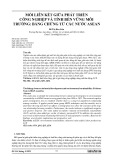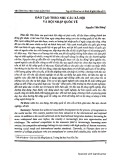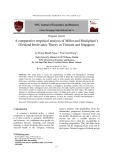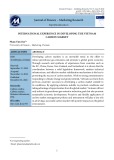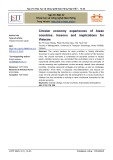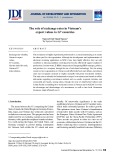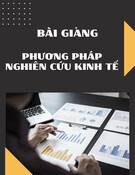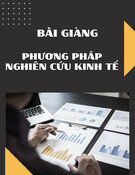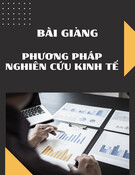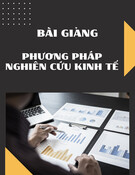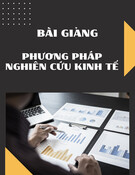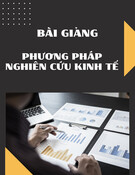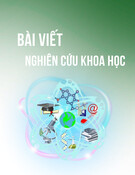
No 14 - 12.2024 - Hoa Binh University Journal of Science and Technology 29
ECONOMY AND SOCIETY
PROMOTING THE EXPORT OF VIETNAMESE RICE
TO INDONESIA
Dr. Vu Kim Dung
Foreign Trade University
Corresponding Author: dungvk@ftu.edu.vn
Received: 01/12/2024
Accepted: 10/12/2024
Published: 24/12/2024
Abstract
Vietnam has long been one of the world's leading exporters of rice. In recent years, Indonesia
has emerged as s key importer of Vietnamese rice. In 2023, Indonesia became Vietnam's second-
largest rice importer, purchasing over 1.1 million tons, which generated more than USD 640 million.
This marks a dramatic increase of 878% in volume and 992% in value compared to 2022 (Ministry
of Industry and Trade, 2024). However, alongside this remarkable growth in rice export turnover,
Vietnamese enterprises face several challenges in exporting rice to this market. This article analyzes
the status-quo of Vietnamese rice exports to Indonesia, identifies the opportunities and challenges
enterprises encounter, and proposes some solutions to enhance rice exports from Vietnam to
Indonesia in the future.
Keywords: Vietnam, Indonesia, rice exports.
Thúc đẩy xuất khẩu gạo Việt Nam sang thị trường Indonesia
TS. Vũ Kim Dung
Trường Đại học Ngoại thương
Tác giả liên hệ: dungvk@ftu.edu.vn
Tóm tắt
Việt Nam từ lâu đã trở thành một trong những nhà xuất khẩu gạo hàng đầu trên thế giới. Trong
những năm gần đây, Indonesia là một trong những quốc gia chủ lực nhập khẩu gạo từ Việt Nam.
Năm 2023, Indonesia đã vươn lên trở thành nhà nhập khẩu lớn thứ 2 của Việt Nam với sản lượng
hơn 1,1 triệu tấn, thu về hơn 640 triệu USD, tăng mạnh 878% về lượng và tăng đến 992% về trị giá
so với năm 2022 (Bộ Công thương, 2024). Tuy nhiên, cùng với sự tăng trưởng đột phá trong kim
ngạch gạo xuất khẩu, các doanh nghiệp Việt Nam cũng phải đối diện với một số thách thức khi xuất
khẩu gạo sang thị trường này. Bài viết phân tích thực trạng xuất khẩu gạo Việt Nam sang Indonesia,
những cơ hội và thách thức mà doanh nghiệp gặp phải, đồng thời, đề xuất một số giải pháp nhằm
thúc đẩy xuất khẩu gạo từ Việt Nam sang Indonesia trong thời gian tới.
Từ khóa: Việt Nam, Indonesia, xuất khẩu gạo.
1. Vietnam’s Rice Export Turnover to Indonesia
Vietnam has consistently ranked among
the top three largest rice-exporting countries
in the world, alongside India and Thailand.
Each year, between 6 and 8 million tons of
rice to global markets , with Vietnamese rice
currently being shipped to more than 150
countries and territories.

30 Hoa Binh University Journal of Science and Technology - No 14 - 12.2024
ECONOMY AND SOCIETY
Figure 1. Vietnam's Rice Export Volume and Turnover from 2019 to 2023
Unit: Million tons/billion USD
Source: Trade Map
Vietnam's rice exports in the 2019-2023
period have experienced significant growth in
both volume and value, despite fluctuations
in the global market. The total export volume
increased from 5.46 million tons in 2019 to a
record 8.1 million tons in 2023, representing
an increase of more than 52%. After 34 years
of participation in the global market, Vietnam's
rice industry has achieved record levels in
both volume and value. This demonstrates
that Vietnam has not only maintained but also
strengthened its position among the leading
rice-exporting countries worldwide.
This growth was partly driven by increased
global demand for rice, influenced by factors such
as the Russia-Ukraine conflict and droughts in
some major exporting countries. Concurrently,
large markets like China have also increased
their purchases, creating favorable conditions
for Vietnamese rice to penetrate and expand in
these markets. Additionally, the government's
initiatives to enhance rice quality, simplify
administrative procedures, and diversify export
markets also played an important role.
In 2022, although there was a decrease in
export output to 4.38 million tons due to the
impact of some factors such as fluctuations in
world rice prices, disruptions in the supply chain,
and limited supply, Vietnam's rice export prices
increased, so the export value still increased to
3.19 billion USD. Thus, from 2021 onwards,
the export value has recovered and grown
continuously, especially exploding in 2023 when
the export turnover reached 4.68 billion USD, an
increase of 38.4% compared to 2022. In general,
the prospect for Vietnam's rice exports in the
coming years remains very positive thanks to
high market demand and support measures from
the government and businesses.
2. Competitiveness of Vietnamese Rice in the
Indonesian Market
The competitiveness of Vietnamese rice in
the Indonesian market is influenced by several
factors, including product quality, the ability
to meet demand, and the preferential trade
conditions established through trade agreements.
Rice Quality
Vietnamese rice is famous for its high
quality, diverse varieties, and suitability to the
needs of many different markets. Rice varieties
such as Jasmine, ST24, and ST25 have been
recognized worldwide for their quality and
flavor. In particular, ST25 won first prize in the
World's Best Rice Contest in 2019. Stable rice
quality and ensuring food safety are strengths
that help Vietnamese rice compete well in
the Indonesian market, where consumers are
increasingly concerned about food quality and

No 14 - 12.2024 - Hoa Binh University Journal of Science and Technology 31
ECONOMY AND SOCIETY
safety. However, Thai rice, especially Hom
Mali rice (Jasmine rice), has long been known
for its excellent quality and flavor, building a
solid reputation in the global market. Indian
rice, meanwhile, is famous for Basmati, a long-
grained and aromatic rice that is popular in
many countries. Vietnam, thanks to continuous
quality improvements, is gradually narrowing
the gap and even surpassing in some segments,
but Thailand and India still hold strong positions
thanks to long-standing brand recognition.
The diversity of rice varieties helps Vietnam
meet the needs of many different market
segments, from daily consumption to high-end
products. Currently, Vietnamese rice not only
dominates the world market in terms of output
but also leads the world in terms of selling
price. This is a clear shift from "quantity" to
"quality", a mark of the rice production industry
in the development process towards high
quality, following a closed value chain, taking
green growth as the foundation, ensuring food
security, safety and adapting to climate change.
On November 27, 2023, Decision No. 1490/
QD-TTg approved the Project "Sustainable
development of one million hectares of high-
quality, low-emission rice cultivation associated
with green growth in the Mekong Delta by 2030".
By 2030, the amount of exported rice with high-
quality, low-emission brands will account for
more than 20% of the total rice export volume
of the entire specialized cultivation region.
While Thailand and India still maintain a
strong position thanks to their long-standing
brands, Vietnam is gradually asserting its
position through remarkable strides in product
diversification. With perseverance and the
right development strategy, Vietnamese rice is
gradually building a strong brand and capturing
international market share, ready to compete with
countries with long-standing traditions in the rice
export industry such as Thailand and India.
Ability to Meet Demands
Vietnam has a large rice production
capacity, with stable and continuously growing
annual rice output. During the period 2019-
2023, Vietnam has demonstrated its ability to
supply rice in a timely manner and meet the
large import demand from Indonesia, even in
the context of international fluctuations and
challenges from epidemics and natural disasters.
Stability in production and continuous rice
supply are key factors helping Vietnam maintain
and expand its market share in Indonesia
Specifically, in 2023, global rice supply
will no longer be abundant as India - accounting
for 40% of global output - reduced output by
4 million tons compared to the previous year,
to only 132 million tons. Other markets such
as the Philippines, Indonesia, Cambodia,
Thailand, etc. are also forecast to reduce output
due to the impact of the El Nino phenomenon
and climate change.
On the Vietnamese side, according to the
Ministry of Agriculture and Rural Development,
the country's rice output in 2023 reached 43.5
million tons, up 1.9%, due to an increase in area
of 10,600 hectares (up 0.1%) and productivity
of 6.1 tons/ha, up 1 ton/ha (up 1.7%). With the
above output, Vietnam has met the domestic
consumption, processing, animal feed needs and
has surplus for export. In 2023, rice exports will
reach a record high of nearly 8.3 million tons
to earn 4.78 billion USD, up 38.4% compared
to 2022. In 2024, with an area of 7.1 million
hectares of cultivation, the agricultural sector
will intensify to increase productivity so that
rice output reaches 43 - 43.5 million tons.
Vietnam’s ability to respond to market
demand, especially in the context of global
supply shortages, has helped strengthen its
competitive position. Flexibility in production
and a strategy to expand cultivated areas, along
with measures to increase productivity, have
helped Vietnam not only maintain stable output
but also improve product quality. This has
allowed Vietnam to continue to meet Indonesia’s
import demand, ensure uninterrupted rice
supply, and maximize export opportunities
when the world market fluctuates.
Brand and Reputation
Brand and reputation are important
competitive factors in the rice export market.
However, the recognition of Vietnamese rice

32 Hoa Binh University Journal of Science and Technology - No 14 - 12.2024
ECONOMY AND SOCIETY
brands in the Indonesian market is not really
clear. In many Indonesian supermarkets, Thai
rice has a recognizable brand for consumers,
thanks to promotional strategies and a long-
standing presence in the market. Strong Thai
rice brands such as Hom Mali have built trust
and popularity among Indonesian consumers,
something that Vietnamese rice is still
struggling to achieve.
3. Opportunities and Challenges for Vietnam’s
Rice Exports to Indonesia in the Current Context
The Indonesian government decided to
increase the rice import quota in 2024 by 1.6
million tons due to a shortage of domestic
rice production due to the delay in planting
the main crop of the year due to a lack of
water for cultivation, affected by the El Nino
phenomenon in 2023 (WTO center, 2024).
With this additional amount of imported
rice, the total rice quota that the Indonesian
government has decided to import in 2024
will be 3.6 million tons. This could be an
opportunity for Vietnamese businesses to
continue exporting rice to a market of nearly
280 million people. Vietnamese businesses
should regularly update market information
and gain opportunities to promote exporting
rice to the Indonesian market.
Additionally, India - one of the world's
largest rice exporters, has restricted rice
exports due to the impact of climate change
and drought, creating a gap in the international
market. India is a major rice supplier to many
countries, including Indonesia. India's decision
to extend its export restrictions in 2024 has
forced Indonesia to look for alternative sources
to ensure food security. Vietnam, with its
abundant and high-quality rice production, can
take advantage of this opportunity to expand
its market share in Indonesia. The shortage of
supply from India has put great pressure on
the global rice market, causing rice prices to
rise. Vietnam, as one of the world's leading
rice exporters, can meet this demand and
supply rice at more competitive prices, thereby
increasing its ability to penetrate and expand
its market share in Indonesia.
4. Challenges in Exporting Vietnamese Rice
to the Indonesian Market
Although Vietnamese rice has established
a foothold in the Indonesian market, the
policy of ensuring food security from
domestic rice sources and maintaining a strict
import management policy on rice will cause
Indonesia's rice import demand to decrease in
the coming time. The Indonesian government
always prioritizes protecting the domestic
agricultural sector, especially rice, to support
the livelihoods of about 14 million rice farmers.
Protecting the rice sector through measures
such as maintaining high import tariffs and
implementing import restrictions will continue
to be a major barrier to Vietnamese rice.
Specifically, Indonesia has excluded rice
from its tariff elimination commitment under
the RCEP Agreement, continuing to apply a
30% tariff on imported rice. This tariff is higher
than the 25% tariff applied under the ATIGA
Agreement (WTO center, 2024).
Moreover, Indonesia’s import policy does
not stop at high tariffs but also includes non-tariff
measures such as import quotas, strict quarantine
requirements and regulations on imported rice
quality. These measures increase import costs and
time, creating additional barriers for Vietnamese
rice exporters. Enterprises face higher costs and
more complicated procedures to ensure that their
rice meets Indonesia’s strict standards.
Finally, competition from other rice
exporting countries such as Thailand and India
is also a significant challenge. These countries
not only have large rice production but are also
trying to improve the quality and reduce the cost
of their products to attract the Indonesian market.
Thailand, with its long experience in the rice
industry, has always been a strong competitor
and is considered to have an advantage over
Vietnamese rice in some aspects.
5. Recommendations for Promoting Vietnamese
Rice Exports to Indonesia
Suggestions for Businesses
To enhance quality control, businesses
should establish a comprehensive quality
inspection system that covers every stage of

No 14 - 12.2024 - Hoa Binh University Journal of Science and Technology 33
ECONOMY AND SOCIETY
production and the supply chain. A robust
quality inspection system, such as Total Quality
Management (TQM) or Hazard Analysis and
Critical Control Points (HACCP), is essential.
TQM promotes the continuous improvement of
products, processes, and services with the active
participation of all members of the organization.
Meanwhile, HACCP is a management system
that ensures food safety by analyzing and
controlling hazards throughout the production,
distribution, and consumption stages.
Using modern technology and equipment is
crucial for improving quality control. Businesses
should invest in automated machinery and sensor
systems to measure key quality indicators, ensuring
accuracy and consistency. This investment
strengthens the precision of the inspection process,
providing reliable quality assurance.
Additionally, businesses must focus on
training their employees. Staff should be equipped
with the necessary knowledge and skills to carry
out quality inspections effectively. Providing
regular training on quality standards, inspection
techniques, and the use of modern equipment is a
key element of ensuring product quality.
Collaborating with reputable quality
inspection and certification organizations is also
recommended. These partnerships not only ensure
that products meet international standards but
also enhance transparency during the inspection
process, boosting customer trust and strengthening
relationships with business partners.
Investing in research and development for
high-quality rice varieties is a vital strategy.
Businesses should focus on developing new
rice strains that meet the requirements of
demanding markets like Indonesia. This can
be achieved through independent research or
partnerships with domestic and international
research institutions, such as the International
Rice Research Institute (IRRI).
Improving production and processing
practices is equally important. Businesses should
adopt international standards in their production
and processing procedures to ensure consistent
quality that meets Indonesia’s food safety
regulations. Certifications such as HACCP,
ISO 22000, and GlobalGAP are critical for
ensuring that rice products comply with stringent
international safety and hygiene standards.
Simultaneously, applying TQM helps businesses
continuously improve their processes, ensuring
high and consistent product quality.
Careful attention must also be paid to
contract negotiations and handling disputes. Such
disputes can have far-reaching consequences,
impacting not only individual companies
but the entire industry. Therefore, businesses
should conduct thoroughly research their
partners and market conditions, as well as draft
clear and detailed contracts. If disputes arise,
businesses must consult relevant authorities
and avoid actions or statements that could
harm the reputation of Vietnam’s rice industry
as a whole. Solidarity and ethical competition
among exporters are crucial to maintaining the
industry’s reputation and preventing external
groups from exploiting conflicts to the detriment
of Vietnamese businesses.
To enhance the position and value of their
brands, Vietnamese businesses need to invest in
marketing and product promotion. Professional
campaigns across various platforms, including
television, newspapers, social media, and
other digital channels, are necessary to raise
awareness of Vietnamese rice. Businesses can
create websites, YouTube channels, TikTok, and
Instagram accounts to share videos highlighting
the production process and cultural stories behind
their rice products, connecting more effectively
with younger consumers. Meanwhile, traditional
advertising methods, such as television and
radio, can target older audiences who prefer
these channels. Participating in international
agricultural and food fairs also helps businesses
promote their products directly to consumers
and business partners.
A compelling brand story is another critical
element. Businesses should craft a story that
highlights the origins of their rice, the production
processes, and the cultural values attached to the
product. For example, emphasizing Vietnam’s
long history of rice cultivation, traditional farming
methods combined with modern technology,



